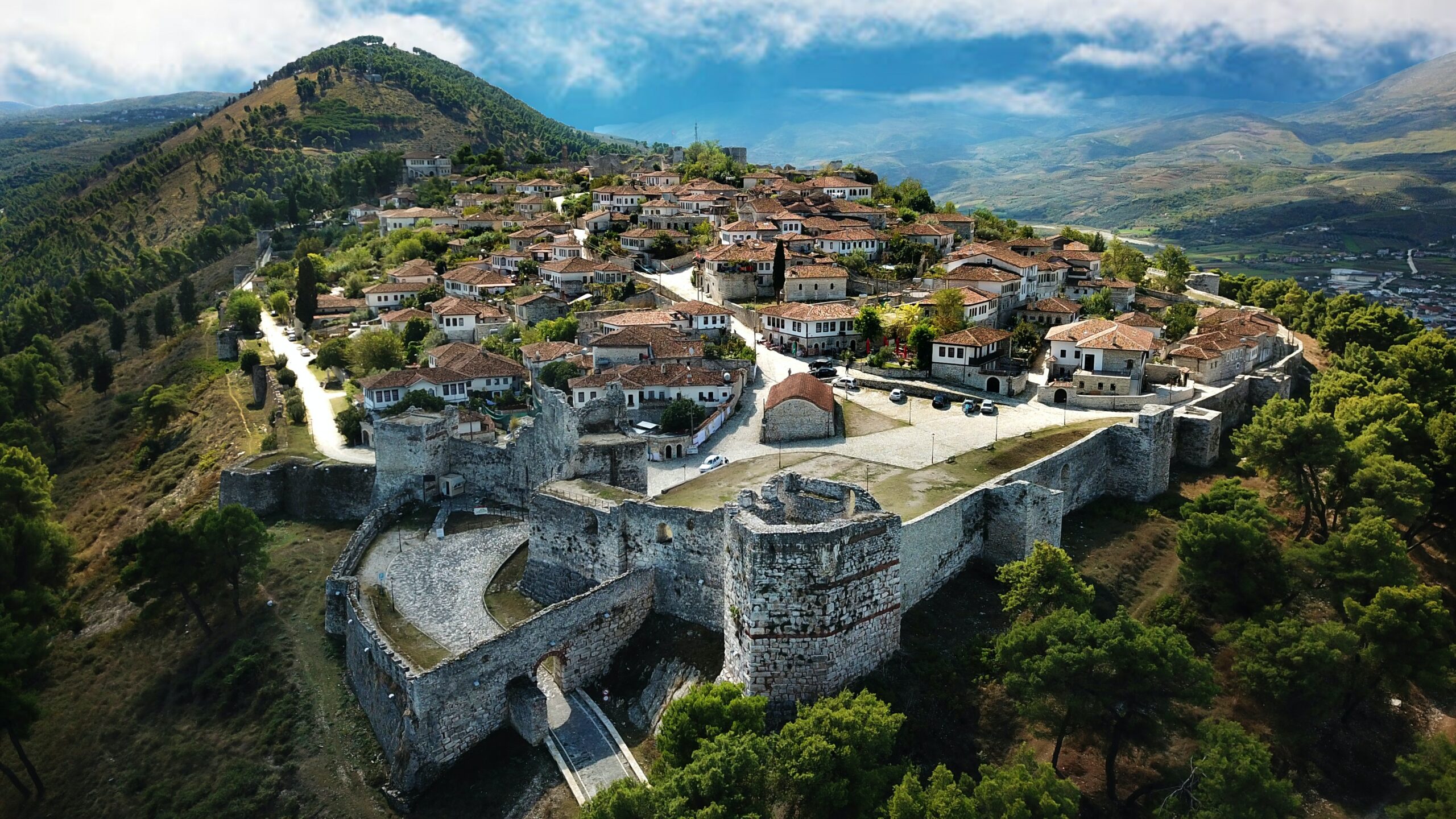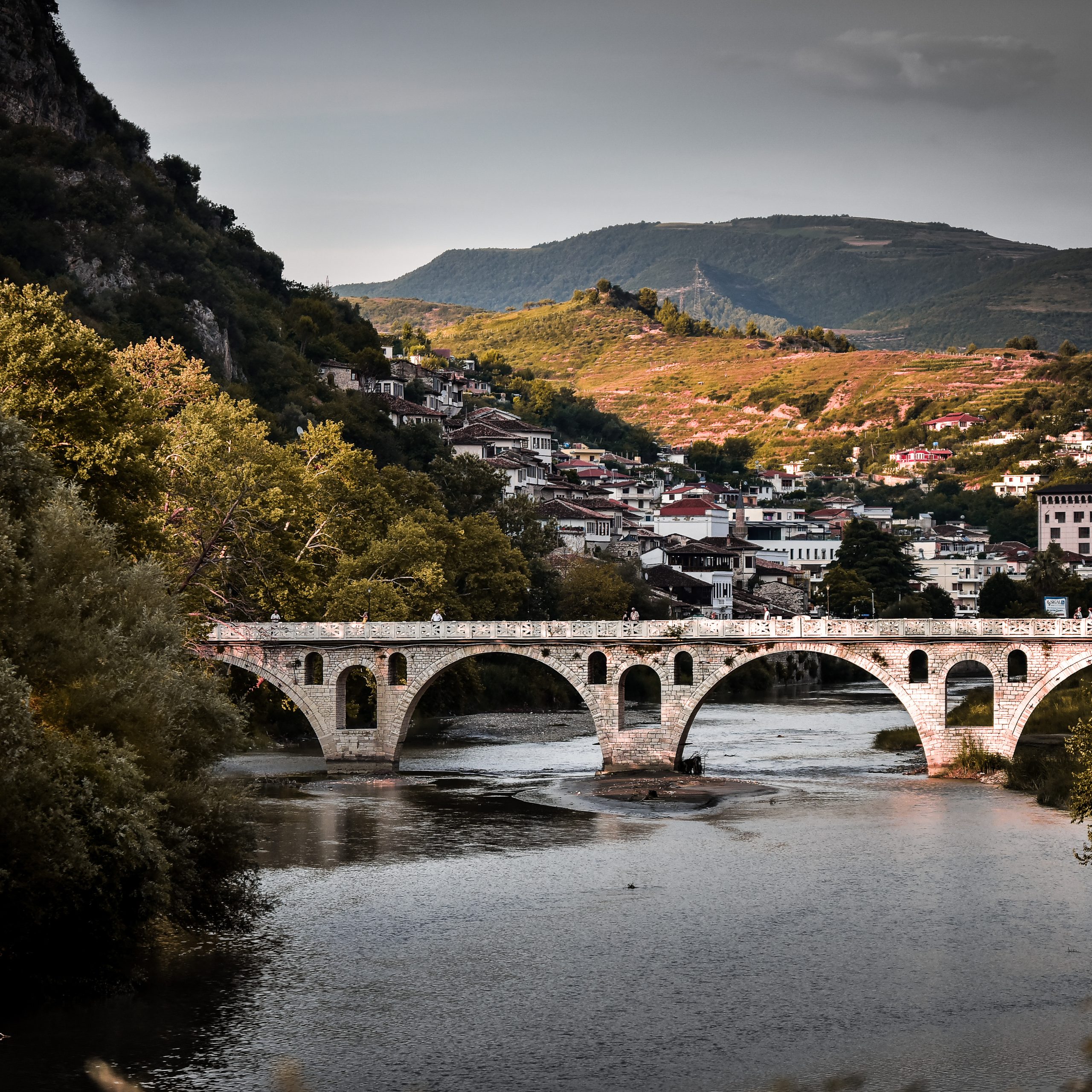


Berat County is one of Albania’s most enchanting destinations, offering travelers a blend of rich history, vibrant culture, and breathtaking natural beauty. Often referred to as the “City of a Thousand Windows,” Berat is renowned for its well-preserved Ottoman architecture, UNESCO World Heritage status, and the serene Osum River flowing through its picturesque valleys. Nestled between mountains and rivers, the county provides a perfect combination of cultural exploration, outdoor adventures, and culinary delights.
Visitors can wander through cobblestone streets, explore centuries-old churches and mosques, hike scenic trails, or enjoy Albanian wine tasting in local vineyards. This comprehensive Berat travel guide will help you discover the county’s top attractions, hidden gems, practical travel tips, and immersive experiences that make it a must-visit destination in Southern Albania. Whether you’re a history buff, a nature lover, or a foodie, Berat County promises unforgettable experiences for every traveler.
Berat County geography is defined by a harmonious mix of mountains, rivers, and fertile valleys. Located in Southern Albania, the county is bordered by Fier, Korçë, and Elbasan, placing it within easy reach of Tirana, the capital. The Osum River, one of the county’s defining features, carves its way through the landscape, creating the stunning Osum Canyon and providing opportunities for rafting, kayaking, and scenic hikes.
The county’s terrain ranges from the low-lying valleys ideal for vineyards and olive groves to the towering Tomorr Mountain, which reaches 2,416 meters and dominates the skyline. This varied topography contributes to a Mediterranean climate, with hot, dry summers and mild winters, making Berat County a year-round destination for tourists. Hiking trails, panoramic viewpoints, and riverbanks offer natural beauty that complements the region’s rich cultural heritage.
Berat County is home to approximately 140,000 residents, spread across five key municipalities: Berat, Dimal, Kuçovë, Poliçan, and Skrapar. The city of Berat, the county seat, serves as the cultural and historical heart, while smaller towns like Kuçovë and Poliçan provide insights into local crafts, agriculture, and industrial heritage. Skrapar, with its mountainous terrain, is famous for raki production and scenic landscapes, making it ideal for outdoor excursions.
The county’s population is culturally diverse, reflecting centuries of Ottoman, Byzantine, and Albanian influences. Local communities have preserved traditional crafts, music, and cuisine, offering visitors an authentic experience. The blend of urban centers and rural villages ensures that tourists can enjoy both lively markets and tranquil countryside escapes.
Berat history spans more than 2,400 years, from ancient Illyrian settlements to the thriving Ottoman town we see today. Known as Ottoman Berat, the city became a cultural hub during the Ottoman era, with whitewashed houses cascading down hillsides, forming the iconic “thousand windows” pattern. Churches, mosques, and bridges from this period remain intact, offering a glimpse into a multicultural past.
Berat has been a strategic location through the ages, serving as a center for trade, religion, and governance. The county’s historical importance is reflected in its architecture, museums, and monuments. Landmarks such as Berat Castle, King Mosque, and Saint Demetrius Cathedral showcase the region’s rich heritage. Today, Berat County not only attracts history enthusiasts but also travelers seeking a deeper connection with Albania’s enduring cultural legacy.
Berat Castle is the crown jewel of Berat County, a fortress that dominates the city skyline and tells stories of centuries past. Built on a hill overlooking the Osum River, this well-preserved castle complex dates back to the 4th century BC and served as a strategic stronghold during the Byzantine and Ottoman periods. Within its walls, visitors can explore cobblestone streets, traditional houses, and several key historical sites, including the Onufri National Iconographic Museum, which showcases exquisite religious art, and King Mosque, an Ottoman-era gem. The Saint Demetrius Orthodox Cathedral also stands as a testament to the region’s multi-religious heritage.
Walking through the castle grounds offers panoramic views of the city and the surrounding mountains, perfect for photography enthusiasts. Guided tours provide context on the castle’s military, cultural, and religious significance, making it a must-visit for anyone exploring Berat tourism.
The historic center of UNESCO Berat earned its World Heritage status due to its exceptional Ottoman architecture and harmonious urban landscape. Often called the “City of a Thousand Windows,” the nickname comes from the whitewashed Ottoman houses stacked on hillsides, giving the impression of countless eyes watching over the city. Narrow streets wind through the old town, revealing hidden churches, mosques, and artisan shops.
Walking tours of the old town allow visitors to experience centuries-old architecture while learning about Berat’s cultural and historical legacy. Every corner tells a story, from local legends to Ottoman-era crafts, making this part of Berat travel guides highly recommended for history lovers and photographers alike.
The Osum River carves the stunning Osum Canyon, one of the most striking natural landscapes in Berat County. Ideal for adventure seekers, the canyon offers hiking trails, rafting opportunities, and rock-climbing spots. Nature lovers can also explore Bogova Waterfall and Tomorr Mountain, both offering spectacular views and well-marked paths for trekking.
For those seeking more relaxed outdoor activities, riverside walks and picnic spots along the Osum River provide scenic escapes from the city. Local guides often combine cultural tours with hiking adventures, making it easy to experience both Berat attractions and its natural beauty in a single day.
Berat culture comes alive through wine, cuisine, and local crafts. Visitors can enjoy Albanian wine tasting in nearby vineyards, sampling regional varieties while learning about traditional production methods. Culinary enthusiasts can indulge in Albanian cuisine in Berat, trying dishes like Tavë kosi, fresh seafood, and sweet pastries at local taverns.
Artisan workshops offer a glimpse into the county’s rich craft traditions, including pottery, textiles, and wood carving. Cultural experiences in Berat are not just about sightseeing—they are immersive journeys into the region’s living heritage, perfect for travelers seeking authenticity.
Things to do in Berat County include a variety of guided tours and outdoor adventures. Walking tours of the old town provide insight into Berat’s Ottoman heritage, while hiking trails up Tomorr Mountain or along the Osum Canyon offer active ways to experience the region’s landscapes. Local guides often combine history, nature, and storytelling, making each tour both informative and engaging.
For wine enthusiasts, Albanian wine tasting tours are available in surrounding vineyards, often paired with traditional dishes for a full sensory experience. Customized day trips and small-group excursions allow visitors to explore Berat at their own pace while ensuring no landmark or hidden gem is missed.
Berat travel guides often highlight the county’s culinary scene, and for good reason. From cozy family-run restaurants to more modern bistros, visitors can savor authentic Albanian cuisine in Berat. Recommended dishes include Tavë kosi, byrek, fresh fish from nearby rivers, and local desserts.
Many restaurants are located in the old town, offering charming views of Berat Castle or the Osum River. Some establishments also provide wine pairings featuring local vintages, giving tourists a taste of the region’s vibrant gastronomic culture.
Cultural life in Berat is lively, with festivals and seasonal events showcasing music, arts, and folklore. Annual wine festivals allow visitors to sample local wines and enjoy traditional dances, while religious and cultural celebrations highlight centuries-old traditions.
Visitors planning their trip can align their visit with events to enhance their experience. Festivals provide a perfect way to engage with locals, sample regional cuisine, and witness Berat culture in full swing.
When planning your Berat travel guide, understanding the climate is essential. The best time to visit Berat County is during spring (April to June) and autumn (September to October). During these seasons, the weather is mild, the landscapes are lush, and tourist crowds are smaller, allowing for a more relaxed experience. Summers (July and August) can be hot, especially in the valleys, while winters are cooler, but still pleasant compared to northern Albania.
Visiting in spring or autumn also provides ideal conditions for hiking tours in Berat, exploring the Osum Canyon, or enjoying Albanian wine tasting in local vineyards. Seasonal festivals and cultural events often take place in these periods, offering an authentic glimpse of Berat culture.
How do I get to Berat County from Tirana?
What accommodation options are available in Berat County?
Visitors to Berat County can choose from a variety of stays to suit different budgets and preferences:
Booking in advance is recommended, particularly during peak tourist seasons or local festivals, to ensure the best accommodations and locations.
Are there guided wine tasting tours in Berat?
Yes, Albanian wine tasting tours are widely available throughout Berat County. Local vineyards offer tastings paired with traditional dishes, vineyard walks, and insights into the winemaking process. These tours are often combined with scenic drives or guided cultural tours of the old town, providing a comprehensive experience for both wine enthusiasts and history lovers.
Visitors can enjoy:
Berat County is internationally known for its UNESCO World Heritage historic center, Ottoman-era architecture, and the iconic “City of a Thousand Windows.” The county is also celebrated for the Osum River, scenic mountains, cultural festivals, and authentic Albanian cuisine in Berat. Visitors often come to explore Berat Castle, historical churches and mosques, and vineyards offering Albanian wine tasting tours.
Top Berat attractions include:
These landmarks offer a mix of history, culture, and nature that makes Berat tourism so memorable.
Berat Castle served as a strategic military stronghold from ancient times through the Ottoman period. It protected the city from invasions and became a center for political and religious life. Today, it provides panoramic views of the city, museums, and preserved churches, offering insight into centuries of Albanian history.
Absolutely. Berat County offers family-friendly attractions such as guided walking tours, interactive museums, easy hiking trails, and cultural festivals. Outdoor activities like gentle river walks and vineyard visits are safe for children, while local restaurants provide familiar dishes alongside traditional Albanian cuisine.
Visitors can enjoy Albanian cuisine in Berat at a variety of restaurants and taverns in the old town. Must-try dishes include Tavë kosi, byrek, fresh river fish, and sweet pastries. Many eateries also pair meals with Albanian wine tasting experiences, making dining both flavorful and culturally immersive.
Berat County is a destination where history, culture, and nature converge. From the towering walls of Berat Castle to the winding streets of UNESCO Berat, and the adventurous trails along the Osum River, every visitor can experience a unique slice of Albania’s heritage. Cultural experiences like wine tasting tours, exploring traditional cuisine, and participating in local festivals add depth and authenticity to any trip.
For travelers seeking a memorable journey filled with history, culinary delights, and breathtaking landscapes, Berat County is the perfect choice. Book your personalized Berat tour, guided hiking adventure, or wine tasting experience today through albaniaturism.com and discover why this “City of a Thousand Windows” continues to captivate visitors from around the world.
